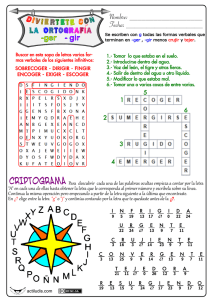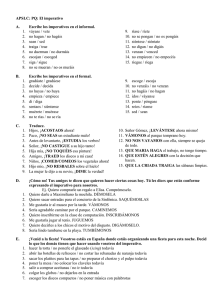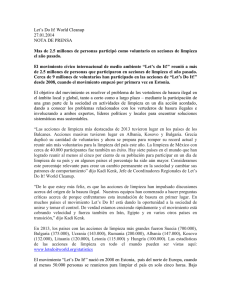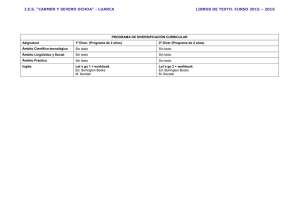Módulo III
Anuncio
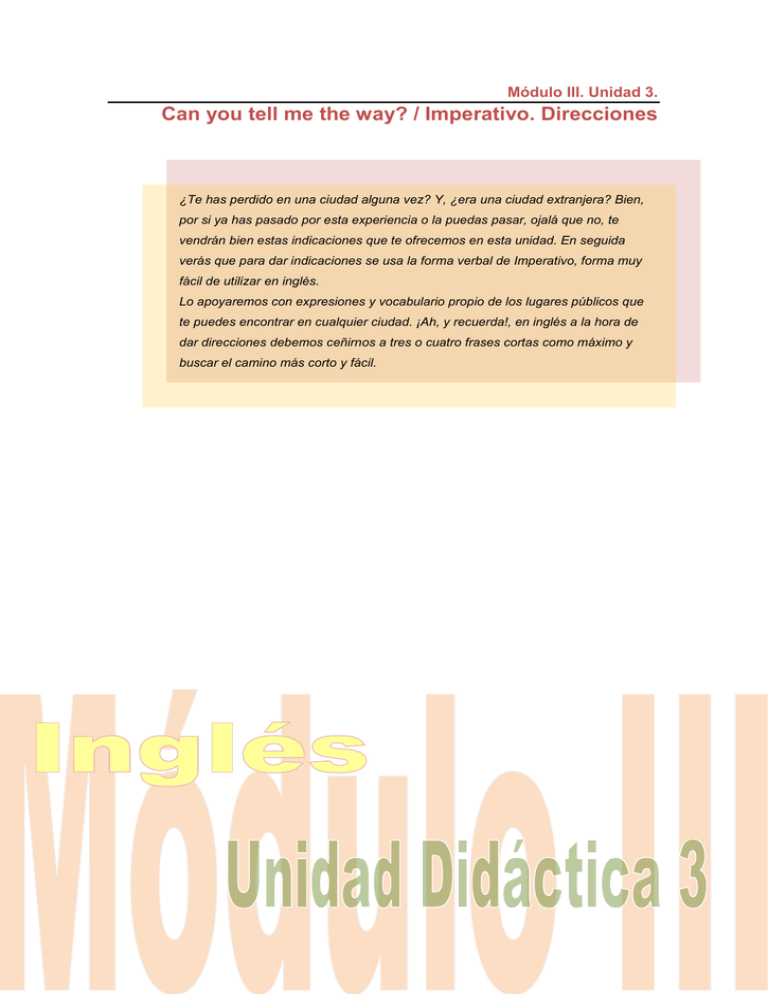
Módulo III. Unidad 3. Can you tell me the way? / Imperativo. Direcciones ¿Te has perdido en una ciudad alguna vez? Y, ¿era una ciudad extranjera? Bien, por si ya has pasado por esta experiencia o la puedas pasar, ojalá que no, te vendrán bien estas indicaciones que te ofrecemos en esta unidad. En seguida verás que para dar indicaciones se usa la forma verbal de Imperativo, forma muy fácil de utilizar en inglés. Lo apoyaremos con expresiones y vocabulario propio de los lugares públicos que te puedes encontrar en cualquier ciudad. ¡Ah, y recuerda!, en inglés a la hora de dar direcciones debemos ceñirnos a tres o cuatro frases cortas como máximo y buscar el camino más corto y fácil. Índice 1. ORACIONES IMPERATIVAS ................................................................................................... 3 1.3. Let’s: ................................................................................................................................... 3 1.1. Verbo en imperativo afirmativo .......................................................................................... 3 1.2. Verbo en imperativo negativo ............................................................................................ 4 1.3. Let’s .................................................................................................................................... 5 2. DIRECCIONES.......................................................................................................................... 8 2.1. Expresiones para preguntar por el camino ........................................................................ 8 2.2. Preguntas para llegar a un lugar y sus respuestas ........................................................... 8 2.3. Instrucciones ...................................................................................................................... 9 2.4. Verbos y preposiciones de movimiento ............................................................................. 9 3. LUGARES PÚBLICOS ........................................................................................................... 11 4. EL TRÁFICO Y EL TRANSPORTE ........................................................................................ 13 5.1. La –h- en inglés, ¿es muda o sonora? ............................................................................ 13 EJERCICIOS DE AUTOCOMPROBACIÓN ............................................................................... 14 SOLUCIÓN A LOS EJERCICIOS DE AUTOCOMPROBACIÓN ............................................... 15 SITIOS WEB DE REFERENCIA ................................................................................................. 15 2|Página 1. Oraciones imperativas En las oraciones imperativas en inglés no se necesita expresar el sujeto (you). Estas oraciones tienen varios valores (dar órdenes, hacer sugerencias, etc.) y su formación es bien sencilla. Generalmente, van acompañados de la expresión “please” para no resultar tan expeditivas. Diferenciamos entre: 1.1. Verbo en imperativo afirmativo: Open that door, please. - Abre esa puerta, por favor 1.2. Verbo en imperativo negativo: Don’t open that window, please. - No abras esa ventana, por favor 1.3. Let’s: Let’s begin the game. - Empecemos el juego ¡Para! ¡No pares! ¡Paremos! STOP ! DON´T STOP ! LET´S STOP ! 1.1. Verbo en imperativo afirmativo A) Formación El imperativo tiene la misma forma que el infinitivo sin TO y no requiere el uso del sujeto, el pronombre "you" está implícito (se sobreentiende). Come here! - Ven aquí Stand up! - Levántate El imperativo es uno de los pocos casos en inglés en el que la frase no comienza por el sujeto sino por el verbo directamente. En ocasiones aparece un sujeto que sirve para llamar a la persona a la cual me dirijo, pero su uso no es obligatorio. Peter, shut up! - Cállate, Pedro Mary, pay attention to the teacher! - María, atiende al profesor RECUERDA Si queremos añadir cortesía, nunca está de más añadir please. B) Usos Se utiliza para: Dar órdenes (orders / commands) Call the police! - Llama a la policía Sit down, boys and girls. - Sentaos, niños y niñas Try another pen. - Prueba otro boli 3|Página Dar instrucciones (instructions) direcciones de cómo llegar a los sitios Turn left - Gira a la izquierda Go straight on. - Sigue recto Add sugar to the milk and flour. - Añada azúcar a la leche y la harina Prevenir a alguien de algo (warnings) Watch the step! - Cuidado con el escalón Look out! - Cuidado Mind the step! - Cuidado con el escalón Pedir a alguien que haga algo: Open the window, please! - Abra la ventana, por favor Bring your books to class, please! - Traed los libros a clase, por favor 1.2. Verbo en imperativo negativo A) Formación Para negar, el imperativo utiliza el auxiliar do + not (don´t) al comienzo de la frase. Ambas formas, corta (don’t) o larga (do not) son similares. Don´t worry, be happy! (= Do not worry) - No te preocupes, sé feliz Don´t open the window! (=Do not open) - No abras la ventana Don´t do that! - No hagas eso (=Do not do that) B) Usos Por este medio expresamos lo que está prohibido hacer o decir (prohibitions). Do not walk on the grass. -No pisar la hierba Don't cycle here. -No montar en bici aquí Actividad 1. Match the English imperatives with the Spanish sentences 1 Te has quemado con el sol. 2 Debes explicarle con detalle algo a alguien. 3 Te detiene la policía en tu coche. 4 Le muestras un nuevo cuadro a un amigo. 5 La silla está rota. 6 No hay que hacer mucho ruido. 7 Hace frío. 8 Debes conducir de vuelta a casa. 9 Debes confesar una falta. 10 Vas caminando muy rápido. 11 Eres profesor y tu curso está muy inquieto. 12 La puerta quedó abierta. 13 Alguien va a meter los dedos al enchufe. A Close the door. B Tell me the truth. C Wait a minute. D Listen carefully. E Show me your driving license. F Pay attention. G Give me your opinion. H Don’t do it. I Don’t sit there. J Don’t touch me. K Don’t speak so loud. L Don’t drink so much whisky. M Don’t open the window. 4|Página 1.3. Let’s A) Formación Let + us + infinitivo del verbo Let + us = let’s Let´s + not = let´s not + infinitivo Debemos saber que let + us es lo mismo que let´s, y ésta es la forma que habitualmente se utiliza. Let´s dance! - Bailemos Let´s have something to eat. - Comamos algo A.1) Formación de la negación: Aunque no es muy frecuente su uso, la forma de negar es añadiendo not detrás de let´s. Let’s not get sad! - No nos pongamos tristes Let’s not argue! - No discutamos B) Usos Es la forma más común para hacer sugerencias en inglés. Es una invitación hacia una o más personas y en la cual se incluye también al hablante, es decir se trata de la primera persona del plural. Actividad 2. Choose the best context for the Let’s sentences. 1 Quiero estar sobrio. 2 John nos invitó a todos. 3 Todos lo ejecutivos están aquí. 4 Mejor veamos películas en casa. 5 Estoy cansado. 6 Vamos al club de golf. 7 Mañana por la mañana estoy ocupado. 8 Mañana por la mañana estaría bien. 9 Me duelen los pies. 10 El lunes es el examen de inglés. A Let’s study tomorrow morning. B Let’s go to Phil’s party. C Let’s practice English. D Let’s begin the meeting. E Let’s play golf. F Let’s stay at the hotel. G Let’s not go to the cinema. H Let’s not study tomorrow morning. I Let’s not go for a walk. J Let’s not drink tonight. Actividad 3. Write an order for each situation. Ejemplo: The child doesn’t eat Eat your food! 1. His hands are very dirty. 2. It’s raining. __________________ __________________ 3. Students are playing in the classroom. __________________________ 4. It’s windy and the door is open. _________________________ 5. The alarm clock is ringing at half past seven. _________________________ 5|Página Actividad 4. Make suggestions using let´s with the following verbs according with the pictures. dance, play, 1. _____________ 4. _________ drink, eat, 2. ___________ 5. ___________ have, go 3. _____________ 6. _____________ Fuente: http://www.gobiernodecanarias.org Actividad 5. Make imperative sentences. Use these verbs: to go - to open - to try - to sit - to come - to call - to stay - to take 1. _____________ your book out of your schoolbag. 2. _____________ here! 3. _____________ where you are. Don't move. 4. _____________ down the street. 5. _____________ to be on time. 6. _____________ the window! 7. _____________ still! 8. _____________ 112 !!! This man is dying! 6|Página Actividad 6. Finish this letter. Use these verbs: to open - to forget - to come - to be - to bring - to make - to turn - to wait Dear Lauren, 1.__________ and see me next weekend. I'm in a house by the sea. It is not difficult to find the house. When you get to the crossroads, 3. __________ right and drive to the end of the road. 4. __________ careful. It's a dangerous road. 5. __________ some warm clothes. Don't 2. __________ to bring your bathing suit with you! It is cold in the evenings. If I am not at home when you arrive, don't 6. __________ for me. The key is under the big white stone in the garden. 7. __________ the front door and 8. __________ yourself a cup of tea in the kitchen! See you soon, Jen. 7|Página 2. Direcciones 2.1. Expresiones para preguntar por el camino ¿Me podría decir el camino a ...? Could you tell me the way to ...? ¿Dónde está el / la ... más cercana? Where is the nearest ...? ¿Cómo se llega a ...? How do I get to ...? ¿Hay un / una ...cerca de aquí? Is there a ... near here? ¿Voy bien por aquí para ...? Is this the right way to… ? ¿Cuánto tiempo se tarda en llegar? How long does it take to get there? Ejemplos: ¿Cómo se va al hotel? How can I can to the hotel? / / What is the way to the hotel? ¿Cuánto tardamos en llegar a Segovia? How long does it take to get to Segovia? ¿Dónde está el banco más cercano? Where is the nearest bank? 2.2. Preguntas para llegar a un lugar y sus respuestas Preguntas • Excuse me. Could you tell me the way to the airport? Perdone, ¿podría decirme cómo puedo llegar al aeropuerto? Posibles respuestas – Turn right - Tome la derecha. Turn left - Gire a la izquierda. – Go straight on - Siga todo derecho. – • Excuse me please, where is the bus station? – Go past the church - Vaya por delante de la iglesia. Perdone, por favor, ¿dónde está la estación de autobuses? – Turn right at the traffic lights - Gire a la derecha en el semáforo. • Is there a supermarket near here? ¿Hay un supermercado cerca de aquí? • How do I get to Oxford Street? ¿Cómo voy/llego a la Calle Oxford? • Can you show me on the map? ¿Puede mostrarme (la dirección) en el mapa? – – Go up/down – Suba / baje. – Cross the street - Cruce la calle. – Walk along the street - Camine a lo largo de la calle. – Cross over the river - Cruce al otro lado del río. – Go over the bridge - Cruce al otro lado del puente. 8|Página Actividad 7. Match the directions in English and Spanish ¿Hay un teléfono cerca de aquí? ¿Cómo voy a la Calle Mayor? How do I get to Main Street? Can you show me the way on the map? Perdone, ¿podría decirme cómo puedo llegar al banco? ¿Puede mostrarme la ruta en el mapa? Is there a telephone near here? Excuse me. Could you tell me the way to the bank? 2.3. Instrucciones Fíjate en toda esta batería de expresiones que se pueden utilizar para indicar una dirección: Siga todo recto: Cruce la calle: Vaya hasta ...: Pasado el / la...: Tuerza a la izquierda / derecha: En la primera calle: Tome la primera a la derecha: Tuerza a la izquierda en la calle ...: Dé media vuelta y vuelva a ...: Al llegar a una plaza pregunte: Está al volver la esquina: Al final de la calle: A mitad de la calle: Al principio de la calle: Doblando la esquina: Vaya por esta calle: go straight on, go ahead cross the road go as far as past the ... turn left / right at the first turning take the first turning on the right turn left at / into ... Street turn around and go back to when you get to a square, ask someone it’s just round the corner at the end of the street in the middle of the street at the beginning of the street round the corner go along this road Actividad 8. How do you translate these directions? 1.- Go straight on and turn left. 1.2.- Take the first turning on the left. 2.3.- The bank is round the corner. 3.- 2.4. Verbos y preposiciones de movimiento El significado de los verbos de movimiento se puede precisar usando una preposición y/o un adverbio que concreta el matiz de movimiento. Por ejemplo, el verbo más común para 9|Página este uso es el verbo GO (ir): Go up: subir Go down: bajar Go back: retroceder Go ahead: avanzar Go along: bordear Go past: pasar Go into: entrar Go out of: salir Go across: cruzar Actividad 9. Match the expressions in English and Spanish Go down the stairs Entra en la tienda para preguntar Go past the supermarket Baja por las escaleras Go into the shop and ask Cruza la calle Go across the street Pasa por delante del supermercado En cuanto a las preposiciones que indican movimiento, debes conocer éstas: into out of hacia adentro hacia afuera down along hacia abajo a lo largo under around por debajo alrededor onto sobre across a lo ancho to hacia off up apartado de hacia arriba through over a través por encima from away desde a lo lejos Fíjate cómo se combinan los verbos y las preposiciones: WALK (caminar): walk into the house entrar en casa caminando walk out of the house salir de casa caminando Pero si lo que quieres es expresar la situación o posición de algo (dónde está o dónde lo puedes encontrar), se pueden emplear las siguientes preposiciones o frases preposicionales: 10 | P á g i n a Preposiciones y expresiones Significado Opposite – Enfrente de. In front of – Delante de On the corner – En la esquina Behind – Detrás On the left – A la izquierda On the right – A la derecha Next to – Pegado, contiguo a 3. Lugares públicos - tienda de discos: record shop -tienda de vídeos: video shop -estanco: newsagent’s -agencia de viajes: travel agent’s -correos: post oficce -museo: museum -pizzería: pizza bar -floristería: flower shop -glorieta, rotonda: roundabout -semáforo: traffic lights -metro: subway, underground - banco: bank - farmacia: chemist’s - librería: bookshop - cine: cinema - zapatería: shoe shop - papelería: stationary - embajada: embassy - bar: wine bar - cruce: junction - cruce: crossing - paso de cebra: zebra crossing 11 | P á g i n a Actividad 10. Use this city map to give directions starting in the school in Central Avenue Fuente: http://www.catedu.es 1. School café: Take the first right. Go along Oak Street. The café in on your left-hand side 2. School pub: 3. School hotel: 4. School sports centre: 5. School hospital: 12 | P á g i n a 4. El tráfico y el transporte En estos contextos, ya hemos visto que es muy común el uso de imperativos. Actividad 12. Check these means of transport and complete the meanings with these expressions: go by motorbike -go on foot -go by car -go by bus -go by boat ____________ go by bicycle ____________ ____________ ____________ ____________ ____________ ____________ Fuente: http://www.educarex.es/eda 5. Pronunciación 5.1. La –h- en inglés, ¿es muda o sonora? Al contrario que en castellano donde la h es muda, en inglés el sonido –h– se pronuncia casi como la j castellana, pero no tan fuerte. Heart House / ha:rt / (la h se pronuncia casi como una j) / haus / 13 | P á g i n a Actividad 13. Compare the sound of the next pairs of words and write their meaning. meaning meaning and hand ear hear eye high old hold ill hill air hair Ejercicios de autocomprobación Ejercicio 1. Complete the dialogue using the following words: end, excuse, get, next to, right(2), second, straight on, thank, turn, welcome, left, go on 1. ……………………. me, how do I …………………….to the supermarket? 2. Go ……………………. 3. Turn …………………….at the corner. 4. Then take the …………………….road on your ……………………. 5. …………………….to the …………………….of the road. 6. …………………….left there. 7. The supermarket is on your …………………….the baker’s shop. 8. …………………….you very much. 9. You’ re ……………………. Ejercicio 2. Look at the city map and complete the sentences with prepositions of place. Fuente: http://www.ite.educacion.es 14 | P á g i n a 1The cinema is ________________to the restaurant. 2 The car park is___________ the park. 3 The pub is ___________the corner. 4 The clothes shop is ______________ the park and the bank. 5 We are at the supermarket. The bank is _____________the street. Solución a los ejercicios de autocomprobación Ejercicio 1. SOLUCIÓN PROPUESTA (NO ES LA ÚNICA): 1. Excuse me, how do I get to the supermarket? 2. Go straight on 3. Turn right at the corner. 4. Then take the second road on your left 5. Go onto the end, of the road. 6. Turn left there. 7. The supermarket is on your right next to the baker’s shop. 8. Thank you very much. 9. You’ re welcome Ejercicio 2. SOLUCIÓN. 1The cinema is next to the restaurant. 2 The car park is opposite the park. 3 The pub is on the corner. 4 The clothes shop is between the park and the bank. 5 We are at the supermarket. The bank is across the street. Sitios web de referencia Para repasar o ampliar lo que has aprendido a lo largo de esta unidad te recomendamos una serie de sitios web que te podrán ayudar: http://ares.cnice.mec.es/inglesep/ www.inglesmundial.com http://owl.english.purdue.edu www.linguaspectrum.com www.mansioningles.com www.abroadlanguages.com 15 | P á g i n a
